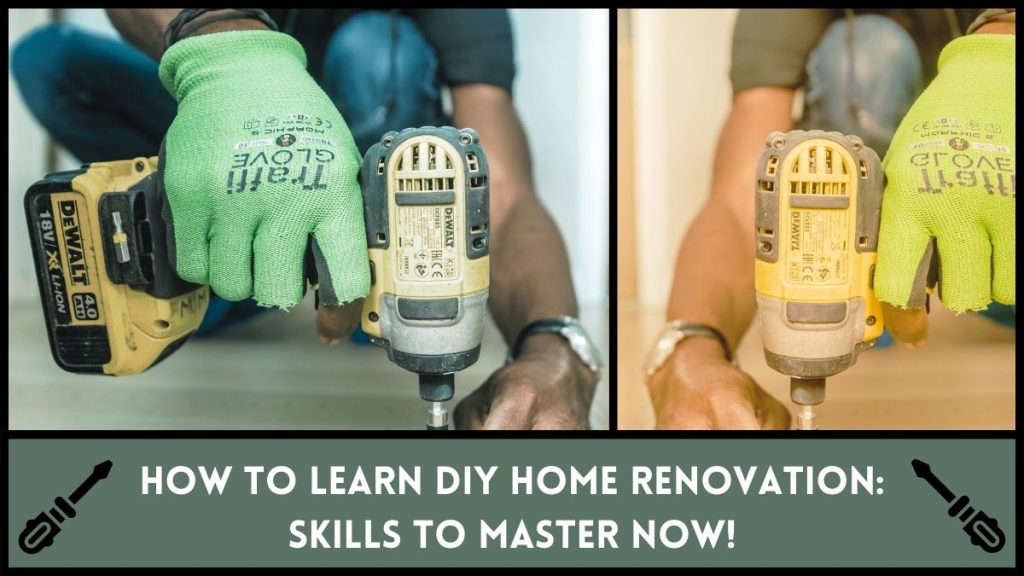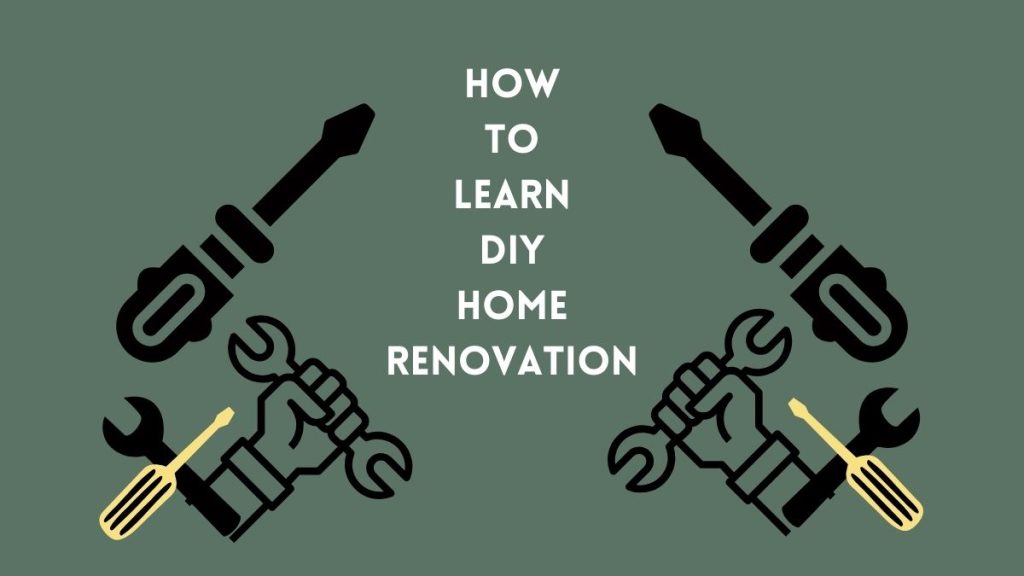Learn DIY home renovation by starting with basic tutorials and gradually tackling more complex projects. Equip yourself with essential tools and safety equipment before beginning.
Tapping into the world of DIY home renovation can transform both your living space and skillset. Begin your journey by digesting online resources, including instructional videos, blogs, and step-by-step guides. Subscribing to home improvement magazines and attending workshops also boost your knowledge and confidence.
Before you dive into your first project, understand your limits—recognize when to call in professionals for complex tasks like plumbing or electrical work. Building a foundation with simpler tasks, such as painting or installing shelves, sets you up for success. Networking with fellow DIY enthusiasts and leveraging social media platforms for tips and tricks can further enhance your learning process, ensuring you’re well on your way to becoming a proficient home renovator.
Related Article: 16 Ways to Make Your Home Better
You may also read: The Ultimate Guide to Solid Roof Pergolas

Related Article: Best DIY Home Decor Ideas: Transform Spaces Easily!
You may also read: Refresh Your Space: Easy Tips for a Stunning Makeover
Essential DIY Home Renovation Skills
Embarking on DIY home renovation requires a diverse set of skills. They ensure both success and safety. Here are the top skills every DIY enthusiast should hone:
Basic Carpentry For Everyday Fixes
Carpentry forms the backbone of DIY home renovations. Knowing your way around wood can save the day. You’ll handle projects such as:
- Fixing a door hinge
- Repairing broken furniture
- Installing shelves
Start by mastering these tools:
| Tool | Use |
| Hammer | For nails and general assembly |
| Screwdriver | For screws and fixtures |
| Measuring Tape | Precise measurements |
Electrical Know-how For Safe Repairs
Working with electricity demands a cautious approach. Key skills include:
- Understanding circuit diagrams
- Replacing outlets and switches
- Installing light fixtures
Always remember:
Turn off the power at the breaker box before starting any electrical work.
Invest in these electrical tools:
- Voltage tester
- Wire strippers
- Insulated pliers
Educate yourself on local codes and regulations.
Related Article: Home Improvement Ideas for Small Houses – A Complete Guide

Credit: www.thepennyhoarder.com
Related Article: Exploring The Best Mobile Home Renovation Ideas: Transform Your Space!
You may also read: Test Your DIY Skills Now
Starting With The Right Tools
Diving into DIY home renovation takes more than just determination and a vision. Your toolkit is your best friend. It transforms that vision into reality. The right tools ensure precision, efficiency, and safety. They make the difference between a job well done and a DIY disaster. Let’s get your toolbox ready!
Must-have Tools For DIY Beginners
A beginner’s toolkit is essential. Here’s a list of the must-have tools to tackle basic home projects:
- Tape Measure: For accurate measuring.
- Hammer: For nails and general carpentry.
- Screwdriver Set: Both flathead and Phillips are crucial.
- Pliers: Needle-nose and adjustable for gripping and bending.
- Adjustable Wrench: For dealing with nuts and bolts.
- Utility Knife: For cutting duties with precision.
- Level: To get pictures and shelves perfectly horizontal.
- Electric Drill and Drill Bits: For holes and driving screws.
- Safety Gear: Glasses and gloves to protect yourself.
Investing In Quality Equipment
Good quality tools are an investment. They last longer and perform better. Here’s how to choose wisely:
| Tool Feature | Why It Matters |
| Material | Stainless steel resists rust. |
| Ergonomics | Comfortable to use, reduces strain. |
| Brand Reputation | Reputable brands offer better quality and warranty. |
| Customer Reviews | Real-world use cases offer insight into tool performance. |
| Price | Being budget-friendly doesn’t always mean poor quality. |
Planning Your Renovation Project
Embarking on a DIY home renovation can be thrilling. It transforms spaces and adds value. Smart planning is vital to avoid costly errors. Consider goals, budget, and room functionality. Expert planning breeds success.
Setting Realistic Goals And Budgets
Renovations vary in scope and expense. Start by pinpointing what you want to achieve. Define clear objectives such as updating a bathroom or expanding a kitchen. Each goal should align with a detailed budget to prevent overspending. Break down costs for materials, tools, and potential help. Prioritize projects that offer high return on investment. Audit your finances to avoid debt traps.
- Analyze current space needs
- Determine essential renovations versus desired ones
- Itemize costs for a transparent budget view
- Factor in a contingency fund for unexpected expenses
Designing Spaces With Functionality In Mind
Form follows function in smart design. Start by assessing the room’s use. Create a layout that maximizes space and flow. Optimize storage with clever solutions. Think about the long-term usability of each area. Make material selections that stand the test of time. Consider natural light, ease of movement, and aesthetic appeal.
| Room | Function | Design Considerations |
| Kitchen | Cooking and Dining | Work Triangle, Storage, Durable Surfaces |
| Bathroom | Bathing and Storage | Moisture Resistance, Efficient Layout, Lighting |
| Living Room | Relaxing and Entertaining | Comfortable Seating, Flow, Personal Style |
Match design elements with your unique style. Select colors and textures that you love. Combine both beauty and utility for a successful renovation. Above all, ensure that each space reflects your needs and desires. With careful consideration, you can craft homes that are both stunning and practical.
You may also read: Very Small Kitchen Ideas on a Budget: Innovative Solutions for Small Kitchen Challenges
Learning From Experts And Resources
Embarking on a DIY home renovation project is an exciting challenge. To ensure success, it’s essential to learn from those who know best. Experienced experts and rich resources can guide you through every step. They help avoid common pitfalls and maximize your efforts. This guidance can transform an overwhelming project into an achievable adventure.
Leveraging Online Tutorials And Workshops
The internet is chock-full of comprehensive guides, how-to videos, and detailed tutorials. Use them to gain practical skills in home renovation.
- YouTube channels: They offer step-by-step video instructions.
- Online platforms: Sites like Coursera and Udemy provide workshops.
- Home improvement blogs: They share tips and tricks learned from personal experience.
- DIY forums: Connect with other DIYers to discuss challenges and solutions.
Utilize these resources to enhance your DIY knowledge base.
When To Consult With Professional Contractors
Despite having a wealth of tutorials at your fingertips, certain tasks call for professional expertise. Knowing when to call in a pro is vital.
| Task | DIY | Consult a Pro |
| Painting Walls | Yes | No |
| Electrical Wiring | No | Yes |
| Laying Tiles | Yes | Consider Expert Advice |
| Structural Changes | No | Yes |
For tasks that carry safety concerns or require permits, consult with a licensed contractor. They ensure work is up to code and done safely.
Hands-on Practice: Key To Improvement
Hands-on practice stands as the cornerstone of mastering DIY home renovation skills. Learning through videos and guides proves useful, but actual improvement blooms through taking action. Rolling up sleeves and diving into projects transforms theory into practical expertise. Whether it’s painting a wall or installing shelves, hands-on work etches valuable lessons into memory. Let’s explore how to build these skills through manageable steps and real-world practice.
Taking On Small Projects First
Starting with small projects builds confidence. These tasks often require fewer tools and less time, making them perfect for beginners. To gain experience, consider the following easy projects:
- Painting a room: It teaches brush techniques and color selection.
- Fixing a leaky faucet: It introduces plumbing basics.
- Replacing door handles: It offers insight into hardware installation.
Each project comes with its unique challenges, which form the learning curve necessary for larger renovations.
Managing Mistakes And Learning From Them
Mistakes are inevitable, yet they fuel learning in DIY projects. Handle them with a proactive mindset. Assess, adapt, and advance should be the mantra after each hiccup. Keep a record of errors in a notebook or digital app, and note the solutions for future reference. Consider creating a simple table for better tracking:
| Error Made | Lesson Learned | Corrective Action |
| Paint dripped on the floor | Always use drop clothes | Apply masking tape on the edges |
| Shelf installed unevenly | Use a level for alignment | Drill new holes and re-mount |
Mapping out missteps could turn a novice into a proficient DIY renovator.
Related Article: Budget DIY Backyard Shade Ideas You’ll Love

Credit: www.youtube.com
Related Article: The Weatherproof Outdoor Storage Solutions: A Complete Guide
Frequently Asked Questions For How To Learn DIY Home Renovation
What Are The Basics Of DIY Home Renovation?
Starting DIY home renovation involves planning, setting a budget, and understanding your skills. Ensure you have the necessary tools and safety equipment. Learning from videos, tutorials, and guides can be very helpful before beginning any project.
Can You Learn Home Renovation Online?
Yes, you can learn about home renovation online through various platforms. Websites like YouTube offer detailed video tutorials. Online courses are available that can provide structured learning from basics to advanced techniques.
How To Start A Home Renovation Project?
Begin with a clear plan detailing the scope and budget. Prioritize projects based on need and skill level. Start with smaller tasks to build confidence. Always follow safety guidelines when using tools and materials.
What Tools Are Needed For Diy Home Renovation?
Essential tools include a hammer, screwdrivers, pliers, tape measure, level, utility knife, and power drill. Depending on the renovation, you may also need specific power tools, ladders, and safety gear.
To learn more about How to Learn DIY Home Renovation>>
Related Article: Sustainable Home Improvements: A Complete Guide to Consider
Conclusion
Embarking on a DIY home renovation journey sharpens your skills and transforms your space. Small, consistent steps lead to stunning results. Remember, resources abound—online tutorials, community workshops, and local hardware stores. Climb the learning curve with enthusiasm, and soon, your dream home will reflect your newfound expertise.
So, grab your tools, and let’s renovate!
Related Article: Expert Decorating Tips for Small Spaces That Work Wonders
You may also read: Basic DIY Skills Every Homeowner Should Know About It
- Basic Rules of Feng Shui: Unlock Harmony at Home - May 7, 2025
- Feng Shui Living Room Rules: Transform Your Space Today - May 6, 2025
- Feng Shui Tips for Beginners: Create Harmonious Spaces - May 4, 2025




Pingback: Refresh Your Space: Easy Tips for a Stunning Makeover - Dwell Gardens
Pingback: Best DIY Home Decor Ideas: Transform Spaces Easily! - Dwell Gardens
Pingback: The Ultimate Guide to Solid Roof Pergolas - Dwell Gardens
Pingback: Basic DIY Skills Every Homeowner Should Know About It - Dwell Gardens
Pingback: Test Your DIY Skills Now - Dwell Gardens
Pingback: The Timeless Elegance of Brass Home Decor - Dwell Gardens
Pingback: Amazing Lantern Decor Ideas for Your Living Room - Dwell Gardens
Pingback: Expert Decorating Tips for Small Spaces That Work Wonders - Dwell Gardens